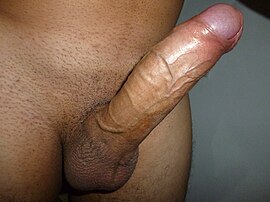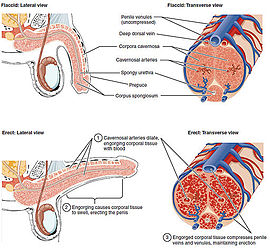
Back Ereksie Afrikaans Erección AN انتصاب القضيب Arabic লিংগ স্তম্ভন Assamese Ereksiya Azerbaijani Pagla'tog BCL Эрэкцыя Byelorussian Эрэкцыя BE-X-OLD Ерекция Bulgarian Canggar BJN
| Erection | |
|---|---|
 Erection of an uncircumcised male human | |
 Three columns of erectile tissue make up most of the volume of the penis. | |
| Identifiers | |
| MeSH | D010410 |
| TE | E1.0.0.0.0.0.8 |
| Anatomical terminology | |
| Erection blood vessels | |
|---|---|
| Identifiers | |
| MeSH | D010410 |
| TE | E1.0.0.0.0.0.8 |
| Anatomical terminology | |
An erection (clinically: penile erection or penile tumescence) is a physiological phenomenon in which the penis becomes firm, engorged, and enlarged. Penile erection is the result of a complex interaction of psychological, neural, vascular, and endocrine factors, and is often associated with sexual arousal, sexual attraction or libido, although erections can also be spontaneous. The shape, angle, and direction of an erection vary considerably between humans.
Physiologically, an erection is required for a male to effect penetration or sexual intercourse and is triggered by the parasympathetic division of the autonomic nervous system, causing the levels of nitric oxide (a vasodilator) to rise in the trabecular arteries and smooth muscle of the penis. The arteries dilate causing the corpora cavernosa of the penis (and to a lesser extent the corpus spongiosum) to fill with blood; simultaneously the ischiocavernosus and bulbospongiosus muscles compress the veins of the corpora cavernosa restricting the egress and circulation of this blood. Erection subsides when parasympathetic activity reduces to baseline.
As an autonomic nervous system response, an erection may result from a variety of stimuli, including sexual stimulation and sexual arousal, and is therefore not entirely under conscious control. Erections during sleep or upon waking up are known as nocturnal penile tumescence (NPT), also known as "morning wood". Absence of nocturnal erection is commonly used to distinguish between physical and psychological causes of erectile dysfunction and impotence.
The state of a penis which is partly, but not fully, erect is sometimes known as semi-erection (clinically: partial tumescence); a penis which is not erect is typically referred to as being flaccid, or soft.